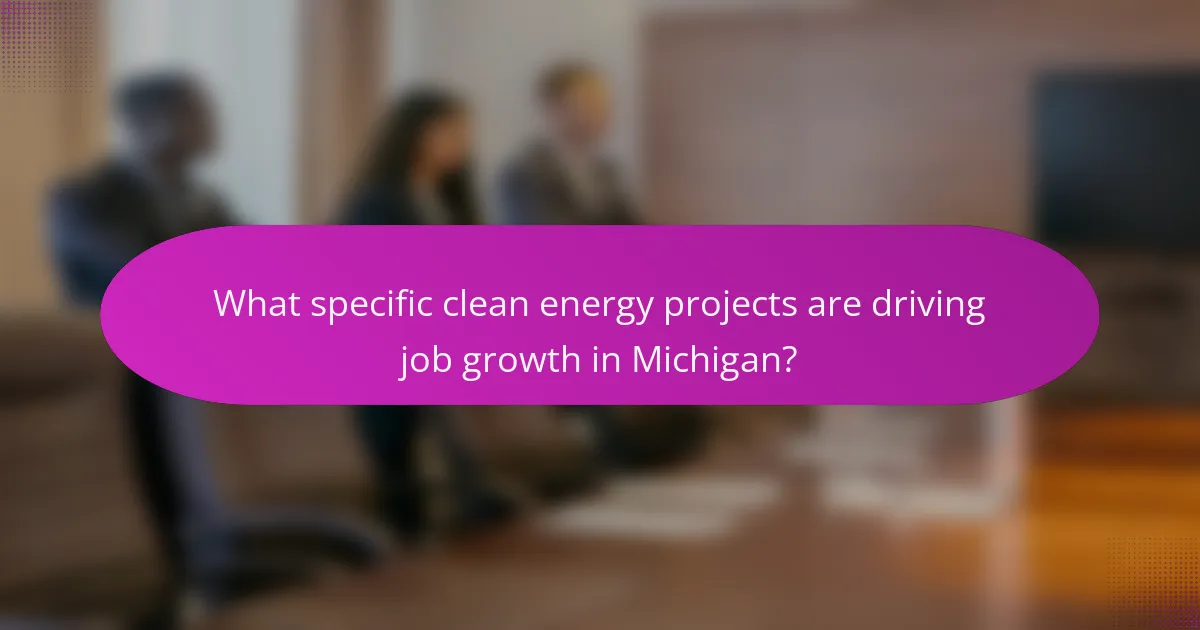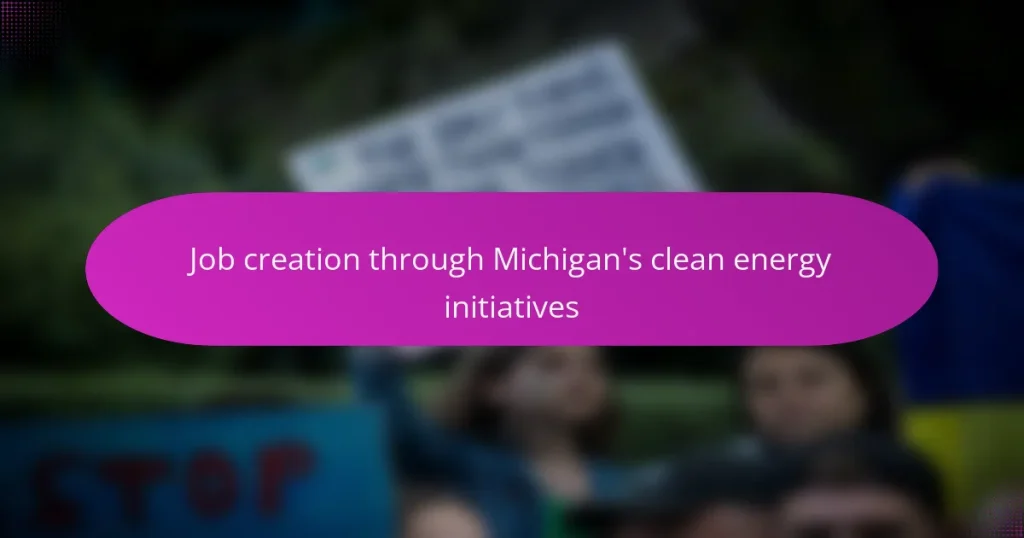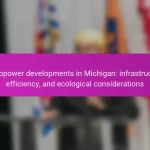
What are Michigan’s clean energy initiatives?
Michigan’s clean energy initiatives focus on increasing renewable energy sources and improving energy efficiency. The state aims to achieve 50% renewable energy by 2030. This includes solar, wind, and hydroelectric power projects. The initiatives also promote energy efficiency programs for homes and businesses. These efforts are designed to reduce greenhouse gas emissions. Additionally, Michigan’s clean energy policies support job creation in the renewable sector. According to the Michigan Energy Innovation Business Council, the clean energy sector has created thousands of jobs. These initiatives are part of a broader strategy to transition to a sustainable energy future.
How do these initiatives contribute to job creation?
Michigan’s clean energy initiatives contribute to job creation by fostering the development of renewable energy projects. These projects require a diverse workforce for installation, maintenance, and operation. For example, solar and wind energy installations create jobs in manufacturing, construction, and engineering. According to the Michigan Energy Innovation Business Council, the clean energy sector employed over 100,000 workers in 2020. Furthermore, investments in clean technology stimulate local economies, leading to additional job opportunities. These initiatives also encourage the growth of related industries, such as energy efficiency services and electric vehicle manufacturing, further enhancing employment prospects.
What types of jobs are being created through these initiatives?
The types of jobs being created through Michigan’s clean energy initiatives include positions in renewable energy, energy efficiency, and environmental management. Renewable energy jobs encompass roles such as solar panel installers and wind turbine technicians. Energy efficiency positions involve energy auditors and building retrofitting specialists. Environmental management jobs include roles focused on sustainability practices and regulatory compliance. According to the Michigan Energy Innovation Business Council, these sectors are projected to see significant growth, contributing to a cleaner economy and job opportunities.
How many jobs have been created so far in Michigan’s clean energy sector?
As of recent reports, approximately 100,000 jobs have been created in Michigan’s clean energy sector. This growth is attributed to various initiatives aimed at expanding renewable energy sources and energy efficiency programs. The state’s commitment to clean energy has fostered job opportunities in solar, wind, and energy efficiency industries. According to the Michigan Energy Innovation Business Council, the clean energy sector has seen significant investment and development, further supporting job creation.
Why is job creation important for Michigan’s economy?
Job creation is crucial for Michigan’s economy as it drives growth and stability. Increased employment leads to higher consumer spending. This spending stimulates local businesses and contributes to overall economic health. Job creation also helps reduce unemployment rates. Lower unemployment fosters a more skilled workforce. A skilled workforce attracts further investments in the state. Additionally, job creation in clean energy initiatives positions Michigan as a leader in sustainable practices. According to the Michigan Energy Innovation Business Council, clean energy jobs have been growing steadily, reinforcing the importance of these initiatives for economic resilience.
How does job creation in clean energy impact local communities?
Job creation in clean energy significantly impacts local communities by enhancing economic stability and providing employment opportunities. Increased job opportunities lead to higher local income levels. This uplift in income stimulates local businesses and services. Clean energy jobs often require skilled labor, promoting workforce development and education. Local communities benefit from investments in renewable energy infrastructure. These investments can improve energy access and reduce utility costs for residents. Additionally, clean energy initiatives contribute to environmental sustainability, improving local air and water quality. Overall, the growth of clean energy jobs fosters community resilience and promotes long-term economic growth.
What are the long-term economic benefits of these jobs?
The long-term economic benefits of jobs created through Michigan’s clean energy initiatives include increased employment opportunities and economic growth. These jobs contribute to a sustainable economy by reducing reliance on fossil fuels. Clean energy jobs often offer higher wages compared to traditional energy sectors. According to a report by the Michigan Energy Innovation Business Council, clean energy jobs in Michigan grew by 12% from 2017 to 2019. This growth leads to increased consumer spending and tax revenues. Additionally, investments in clean energy infrastructure create ripple effects in local economies. Enhanced job stability in clean energy sectors supports long-term community resilience. Overall, these benefits foster a more sustainable and robust economic future for Michigan.

What specific clean energy projects are driving job growth in Michigan?
Several specific clean energy projects are driving job growth in Michigan. Notably, the state is investing heavily in wind energy projects. The development of wind farms has created thousands of jobs in construction, maintenance, and operation. Solar energy projects are also significant contributors. Michigan has seen a rise in solar panel installations, which supports local manufacturing jobs. Additionally, energy efficiency initiatives are being implemented across various sectors. These initiatives promote retrofitting and upgrading facilities, generating employment opportunities in the process. The Michigan Energy Innovation Business Council reports that these clean energy efforts have led to a substantial increase in the state’s green workforce. Overall, Michigan’s commitment to clean energy is fostering job creation across multiple sectors.
How do wind energy projects contribute to employment?
Wind energy projects significantly contribute to employment by creating jobs in various sectors. These projects generate positions in manufacturing, construction, and maintenance of wind turbines. According to the U.S. Department of Energy, the wind sector employed over 116,000 workers in 2019. Job opportunities arise in both skilled and unskilled labor, including engineers and technicians. Local economies benefit from these projects through increased demand for materials and services. Wind energy projects also stimulate long-term employment through ongoing operations and maintenance roles. Michigan’s clean energy initiatives further enhance job creation by promoting local workforce development programs. The state aims to increase its renewable energy capacity, which will likely lead to additional job growth in this sector.
What roles are available in wind energy development?
Roles available in wind energy development include project managers, engineers, technicians, and environmental consultants. Project managers oversee the development process and ensure timelines are met. Engineers design wind turbine systems and optimize energy production. Technicians are responsible for the installation, maintenance, and repair of wind turbines. Environmental consultants assess the ecological impact of wind projects and ensure compliance with regulations. Additionally, roles in research and development focus on improving wind technology. The wind energy sector is rapidly growing, contributing to job creation in Michigan’s clean energy initiatives. According to the U.S. Department of Energy, wind energy jobs have increased significantly in recent years, reflecting the industry’s expansion.
How does the growth of wind farms affect local job markets?
The growth of wind farms positively impacts local job markets. This expansion creates various employment opportunities. Jobs include construction, maintenance, and operation of wind facilities. The American Wind Energy Association reports that each megawatt of wind power generates approximately 1.6 jobs during construction and 0.4 jobs for operations. In Michigan, the wind industry has already created thousands of jobs. Local economies benefit from increased spending and investment. Additionally, wind farms can stimulate ancillary jobs in manufacturing and supply chains. Overall, wind farm growth contributes significantly to job market enhancement.
What role does solar energy play in Michigan’s job market?
Solar energy significantly contributes to Michigan’s job market. The solar industry has created thousands of jobs in installation, maintenance, and manufacturing. According to the Solar Foundation’s National Solar Jobs Census, Michigan had over 9,000 solar jobs in 2021. This number represents a 20% increase from the previous year. Solar energy jobs are projected to grow as more initiatives promote renewable energy. The state aims to achieve 50% renewable energy by 2030, further boosting employment opportunities. Local companies are investing in solar technology, driving job creation in the sector. Overall, solar energy plays a crucial role in diversifying Michigan’s economy and enhancing job growth.
What job opportunities are available in solar energy installation?
Job opportunities in solar energy installation include solar panel installers, solar project managers, and solar system designers. Solar panel installers physically mount and connect solar panels on rooftops or ground-mounted systems. They typically receive training through apprenticeships or vocational programs. Solar project managers oversee the planning and execution of solar projects, ensuring they are completed on time and within budget. They often have backgrounds in engineering or construction management. Solar system designers create layouts and specifications for solar installations, requiring knowledge of electrical systems and building codes. The solar industry is projected to grow significantly, with the U.S. Bureau of Labor Statistics estimating a 61% increase in solar installer jobs from 2020 to 2030. This growth reflects the increasing demand for renewable energy solutions.
How is solar energy adoption influencing workforce development?
Solar energy adoption is significantly influencing workforce development by creating new job opportunities. The transition to solar energy requires skilled workers for installation, maintenance, and manufacturing. According to the Solar Foundation’s National Solar Jobs Census, the solar industry employed over 250,000 workers in the U.S. in 2019, indicating robust job growth. In Michigan, clean energy initiatives have led to an increase in training programs focused on solar technology. These programs equip workers with necessary skills, fostering a workforce ready for the evolving energy landscape. Furthermore, the growth of the solar sector often stimulates local economies, enhancing overall employment rates. As more companies invest in solar, demand for qualified personnel continues to rise, further solidifying workforce development in this field.

What challenges does Michigan face in clean energy job creation?
Michigan faces several challenges in clean energy job creation. A primary challenge is the lack of skilled workforce. Training programs are not sufficiently aligned with industry needs. This gap hinders the growth of clean energy sectors. Additionally, regulatory hurdles complicate project development. Complicated permitting processes can delay or deter investments. Financial constraints also pose significant challenges. Many clean energy projects require substantial upfront capital. Limited access to funding can stall initiatives. Furthermore, competition from fossil fuels remains a barrier. Low prices for traditional energy sources can undermine clean energy investments. Lastly, public awareness and acceptance of clean energy technologies are crucial. Misconceptions about renewable energy can slow adoption rates.
How do policy changes affect job growth in clean energy?
Policy changes significantly influence job growth in clean energy. Regulatory frameworks can incentivize investment in renewable energy projects. For instance, tax credits and subsidies can lower operational costs for clean energy companies. This encourages businesses to expand and hire more workers.
Additionally, policies promoting clean energy targets create demand for skilled labor in the sector. A report by the U.S. Department of Energy indicates that states with strong clean energy policies have seen job growth rates 10% higher than those without such initiatives.
Furthermore, policy changes can lead to technological advancements, increasing efficiency and reducing costs. This fosters a competitive market, attracting more companies and leading to further job creation.
What specific policies have been beneficial for job creation?
Policies promoting renewable energy standards and tax incentives have been beneficial for job creation in Michigan’s clean energy sector. The state implemented a Renewable Portfolio Standard (RPS) requiring utilities to source a portion of their energy from renewable sources. This policy has driven investments in wind and solar energy projects. Additionally, tax credits for clean energy investments have encouraged businesses to expand and hire more workers. According to the Michigan Agency for Energy, these initiatives have created thousands of jobs in manufacturing, installation, and maintenance of renewable energy technologies. Furthermore, programs supporting energy efficiency upgrades have also contributed to job growth in related sectors.
What barriers exist that hinder job growth in this sector?
Barriers that hinder job growth in Michigan’s clean energy sector include regulatory challenges, funding shortages, and workforce skill gaps. Regulatory challenges create uncertainty for investors and developers. This uncertainty can delay project approvals and discourage new ventures. Funding shortages limit the ability of companies to expand operations or invest in new technologies. Additionally, workforce skill gaps mean that there are not enough qualified workers to meet the demands of the industry. According to the Michigan Energy Innovation Business Council, 70% of clean energy firms report difficulty in finding skilled labor. These factors collectively impede job creation in the sector.
What skills are necessary for jobs in Michigan’s clean energy sector?
Skills necessary for jobs in Michigan’s clean energy sector include technical knowledge, project management, and communication skills. Technical knowledge encompasses understanding renewable energy technologies, such as solar and wind systems. Project management skills are essential for overseeing clean energy projects from inception to completion. Communication skills facilitate collaboration among diverse teams and stakeholders. Additionally, problem-solving abilities are crucial for addressing challenges in energy efficiency and sustainability. Familiarity with regulations and policies related to clean energy is also important. These skills align with the growing demand for a skilled workforce in Michigan’s expanding clean energy initiatives.
How can individuals prepare for careers in clean energy?
Individuals can prepare for careers in clean energy by gaining relevant education and skills. Pursuing degrees in environmental science, engineering, or renewable energy is essential. Certifications in solar panel installation or energy auditing can enhance job prospects. Networking with professionals in the clean energy sector provides valuable insights and opportunities. Participating in internships or volunteer work related to clean energy builds practical experience. Staying informed about industry trends and technologies is crucial for career advancement. Engaging in local clean energy initiatives can also provide hands-on experience. These steps align with Michigan’s clean energy initiatives, which aim to create jobs in this growing sector.
What training programs are available for aspiring clean energy workers?
Various training programs exist for aspiring clean energy workers. These programs include certifications in solar panel installation, wind turbine technology, and energy efficiency auditing. Community colleges in Michigan offer specialized courses in renewable energy technologies. Additionally, organizations like the Michigan Energy Workforce Development Consortium provide training resources and workshops. Online platforms also feature courses focused on clean energy skills. Many of these programs align with state initiatives to promote job creation in the clean energy sector. According to the Michigan Department of Energy, Labor & Economic Opportunity, these training efforts support the growing demand for skilled workers in renewable energy.
What are best practices for maximizing job creation in clean energy?
Best practices for maximizing job creation in clean energy include investing in workforce training programs. These programs equip individuals with necessary skills for clean energy jobs. Collaboration between educational institutions and industry stakeholders enhances training effectiveness. Implementing supportive policies encourages clean energy projects and job growth. Incentives for businesses adopting clean technologies can drive employment opportunities. Research shows that states with strong clean energy policies see higher job growth rates. For example, a report by the Solar Foundation found that solar jobs grew by 20% in states with supportive legislation. Engaging local communities in clean energy projects fosters job creation and economic development.
How can businesses and government collaborate to enhance job growth?
Businesses and government can collaborate to enhance job growth through public-private partnerships. These partnerships can focus on developing clean energy projects, which create new jobs in Michigan. For example, the Michigan Energy Innovation Business Council reports that clean energy sectors have seen significant employment growth. Government incentives can encourage businesses to invest in renewable energy technologies. Training programs funded by both entities can equip workers with necessary skills. Collaborative research initiatives can lead to innovative solutions that drive job creation. Additionally, regulatory support from the government can streamline processes for businesses entering the clean energy market. This collaboration ultimately fosters a sustainable job market in Michigan.
What innovative approaches can be adopted to increase employment opportunities?
Adopting innovative approaches such as targeted training programs can significantly increase employment opportunities. These programs should focus on skills relevant to the clean energy sector. Partnerships between educational institutions and clean energy companies can facilitate this training. Furthermore, implementing tax incentives for businesses that hire locally can encourage job creation. Establishing incubators for clean energy startups can also foster entrepreneurship. Community outreach initiatives can raise awareness about job openings in this sector. Research shows that regions investing in clean energy initiatives have seen job growth rates of up to 20%. This indicates a strong correlation between clean energy investments and increased employment opportunities.
The main entity of this article is Michigan’s clean energy initiatives, which are designed to enhance job creation while promoting renewable energy sources and energy efficiency. The article outlines how these initiatives aim for 50% renewable energy by 2030 and highlights the significant job growth in sectors such as solar and wind energy, with approximately 100,000 jobs created to date. It also discusses the types of jobs available, the economic impact on local communities, and the challenges faced in workforce development and regulatory frameworks. Additionally, the article emphasizes the importance of policy changes and collaborative efforts between businesses and government to maximize employment opportunities in the clean energy sector.


